Yoga
Vayu Rahasya: The Secret of Vayu

Vayu Rahasya: The Secret of Vayu
Written by Dr. David Frawley,Sept. 2009
The magazine of > Sringeri Shankaracharya Math < , the oldest and most respected of the Shankara monastic centers in India, representing the great tradition of Advaita Vedanta. Dr. Frawley has written many articles for the magazine over the years and been closely connected to the Math.
Vayu, the Cosmic Power
Vayu is one of the key concepts of Vedic thought that has great importance in Yoga, Ayurveda and Vedanta. It has many profound implications both at a cosmic level and relative to our own individual lives. Indeed if one understands Vayu, one understands everything, including time, space and karma, life and death and one’s own deeper Self.
Vayu is usually regarded as the element of air at a material level. This is a good place to begin a study of Vayu, but only the beginning of many correspondences. In Vedic thought, Vayu includes the concept of space or Akasha. Space in motion is air, while air at rest is ether. These are the two sides of Vayu, which is the unity of air and ether. Ether is the field in which Vayu as a force operates.
Modern science recognizes that the universe consists of a fabric of space filled with various types of channels, currents or wormholes that are filled with dynamic interchanges. This is a picture of the cosmic Vayu, which is not only space but the energy within it both potential and actual. One could say that potential energy is space while activated space is air. The universe itself is Vayu in its ethereal vibration.
However, Vayu is much more than the material or even subtle elements. Vayu is the power through which everything comes into manifestation and into which everything eventually returns. Vayu is not just the material element of air and space but the cosmic principle of energy and space that pervades body, life, mind and consciousness. The entire manifest universe arises from space and energy which is Vayu at an outer level. At an inner level, Vayu stands for the formless principle of air and space, the invisible Spirit or Brahman behind the visible world of the earth, water and fire elements, the realm of name and form. The famous Shantipath of the Taittiriya Upanishad declares this:
Namaste Vayo, tvam eva pratyaksham Brahmasi.
`O, Vayu, you are the directly perceivable Brahman.‘
Vayu often symbolizes the supreme deity, the spirit that is formless in nature yet full of power like the wind or air. Vayu as the creative or causal power is the power of Ishvara or the Cosmic Lord. Yet Vayu as the receptacle of all power and the ground of all existence can symbolize the Supreme Brahman as well. Vayu can indicate both Saguna and Nirguna Brahman. Vayu thus often means Spirit, not just the air as an element but the presence of being and consciousness that exists everywhere but cannot be seen anywhere. We find this idea of Spirit or air in many spiritual traditions throughout the world, and in the very term `spiritual‘.
RAYA YOGA – The Royal Yoga
> RAYA YOGA, the Royal Yoga <
> Raya Yoga, der köngliche Yoga <
Der Ausdruck Raja Yoga stammt aus der Hatha Yoga Pradipika. Dort heißt es: „Wir üben Hatha Yoga, um Raja Yoga zu erlangen.“ Denn es ist sehr schwer, nur durch geistig-psychologische Techniken Kontrolle über den Geist zu bekommen. Asanas und Pranayama können uns dabei helfen. So haben eigentlich die Hatha Yoga-Schriften den Ausdruck Raja Yoga für die Sutras von Patanjali populär gemacht. Raja heißt wörtlich „Herrscher“; durch Raja Yoga werden wir zum Herrscher über unseren Geist und unser Leben.
Das Raja-Yoga besteht in der direkten Vereinigung von Manas (also wörtlich übersetzt der Seele) mit Atma. Mit anderen Wort in der Vereinigung des Einzelbewusstseins mit dem Allbewusstsein.
Es ist begreiflich, dass durch das Aufgeben der Individualität der somnambule Zustand (Samadhi) eintritt, aber ist auch klar, dass dieser Weg der schwierigste ist. Nachdem aber das Samadhi seine Unterabteilungen hat, von denen die hauptsächlichsten Samprajnata, d.h. bewusstes und Asamprajnata Samadhi d.h. unter Aufhörung des Bewusstseins sind, so ist es, nach unserer Ansicht klar, das Raja-Yoga sozusagen die Suggestion zu dem selbstinduzierten somnambulen Zustand liefert, welcher dann, da das suggerierte Objekt.
TRADITIONAL YOGA STUDIES (T.Y.S.)
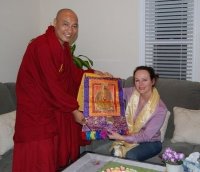
> Y.R.E.F. -Yoga Research and Education Foundation <
> THE YOGA TRADITION < > YOGA IM BUDDHISMUS <
PDF: >> „108 Things You Can Do To Help the Environment„<< – Please take the time to read the amazing document and send it to those you feel could benefit from it.
Green Dharma by Georg and Brenda Feuerstein >>FREE PDF DOWNLOAD <<: It brings us joy to make Green Dharma a free download for two simple reasons:
First, the environmental crisis is extremely severe, and green action is of the utmost urgency. We are hoping that our book might stimulate its readers into appropriate attitudinal change and responsible action. Publishing this book through regular channels would take too long to reach the public, as well as destroy a large number of trees and add to pollution.
Second, we feel it is more appropriate to not charge for a book that shares the Buddha Dharma.
If you wish to donate to TYS, please click on the button below. Your gift will be used to further our work on the environmental and social crisis. Alternatively, you may send a cheque to TYS, P.O. Box 661, Eastend, SK S0N 0T0, Canada.
WORDS OF SRI ANANDAMAYI MA

Benares, August 12 th , 1948.
QUESTION: What are the benefits to be derived from hatha yoga, and what are its drawbacks?
SRI MA: What does ‘hatha’ mean? To do something by force.
‘Being’ is one thing, and ‘doing’ quite another.
When there is ‘being’, there will be the spontaneous manifestation of what is due to be manifested, owing to the prana functioning in a particular centre of the body.
On the other hand, if one practises hatha yoga merely as a physical exercise, the mind will not be transformed in the very least. By physical exercise bodily fitness is developed. One hears quite often of cases where the giving up of the practice of yogic postures and the like, has resulted in physical disorders. Just as the body grows weak from lack of adequate nourishment, so the mind has need of suitable food. When the mind receives proper sustenance, man moves towards God, whereas by catering to the body, he only increases his worldliness.
Mere gymnastics is nutrition for the body.
> Meet Ananda Ma Filmprojekt at facebook <
Homepage of Bhagavan Sri Ramana Maharshi
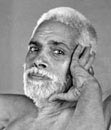
>> Bhagavan Sri Ramana Maharshi <<
December 1879 – April 1950
On very rare occasions throughout the history of mankind, Spiritual giants have appeared to exemplify the Highest Truth, guiding followers by their conduct in every moment of their lives; Bhagavan Sri Ramana Maharshi was such a giant. Unique in our time, He perfectly embodied the ultimate truth of Self-realisation, or complete absorption in the Supreme Itself.
Those who set out upon this quest are fulfilling the true purpose of life itself. This is not an easy path to follow, but be assured that every step taken in pursuit of Self-realisation, accumulates merit that is carried from birth to birth, until that final step is accomplished. This is the testimony of the Sages and doubt should never be allowed to divert you from your course.
Welcome to arunachala-ramana.org, a non-profit website created for the benefit of those who are seriously interested in Advaita and the paths to Self-realisation. This is the more comprehensive sister site to www.ramana-maharshi.org. Please do not forget to bookmark it.
This website is dedicated to Arunachala and the great saints and sages who were attracted by it thoughout the ages, including that of Bhagavan Sri Ramana Maharshi. Visitors to this site are invited to add their own news and comment via the Interactive section of the site.
PAYUL LING – Trad. Bhuddist Yoga Centers
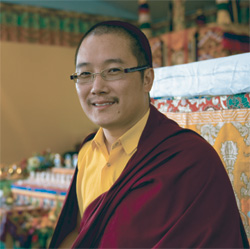
His Holiness Karma Kuchen Rinpoche
>> Guru Yoga, Meditation Teaching <<
Importance of the Oral Transmission
A Teaching given by H.H. Penor Rinpoche in Berkeley, California July 19, 1996
Regardless of the particular level of teaching or practice that we are discussing in the Buddhist tradition, whether it be Hinayana, Mahayana or Vajrayana, the process of spiritual development is one of the student relying upon a teacher. We may call that teacher a lama, a guru, or whatever, but the essential point is that there is an oral transmission that takes place in which a teacher teaches the student: the student listens to the teachings, absorbs their meaning and puts them into practice.
There is a reason for this emphasis on an oral transmission. From the time of the Buddha up to the present day, the buddha dharma has always been transmitted and meant to be transmitted orally, ensuring that there is a living tradition that is still embued with the blessing and power of the original teachings. It also guards against the possibility of so-called teachers simply coming up with their own ideas. Instead, the teacher passes on a proven tradition of teachings.
This makes the buddha dharma different from other kinds of learning where it may be possible for people to innovate. In such realms of learning it may be appropriate to come up with new systems of thought or to introduce new ideas. But when we are talking about the buddha dharma, every teaching must connect with the original teachings of the Buddha in order for a teaching to be valid. The teachings cannot be something that someone is simply coming up with on their own. The teachings are something that the teacher passes on.
Similarly, in other types of human knowledge it may be permissible to present information in a manner as entertaining and pleasing as possible. But although it is important for dharma teachings to be presented in a manner which is pleasant to hear, it is most important that the transmitted teachings have the power to bless and influence those who hear them in a positive way – not only in this lifetime, but in future lifetimes as well. So even though the teaching of the dharma should be elegant and well-presented, what is most important is the blessing of the essential message.
Palyul Centers are located around the globe, providing the facilities for learning and practicing the teachings of the Buddha.
Yogi Lahiri Mahasaya, Authentic Kriya Yoga

Despite all tall claims by others, no one is perhaps as authorised as Shibendu Lahiri (born 1939), the great grand son of famous house holder Yogi Lahiri Mahasaya (1828-1895), to spread the authentic teachings and techniques of Kriya Yoga in the world today.
Yet he says in utter humility that wise wields no authority and those in authority are not wise! Organisations assert authority, but authenticity may be lacking. Mobilisation may create a mafia, but the most sacred may remain untouched. Cultism has no place in matters deeply spiritual.
Lahiri Mahasaya (Full Name: Shyama Charan Lahiri) became known to the truth seekers all over the world through:
> Paramahamsa Yogananda’s famous book
„*Autobiography of a Yogi“* ,
which has been translated in many languages.
MARTIN BUBER: ICH UND DU

>> Ich und Du von Martin Buber (Autor) <<
>> I And Thou (Hardcover) by Martin Buber <<
Amazon.com Review:
I and Thou, Martin Buber’s classic philosophical work, is among the 20th century’s foundational documents of religious ethics. „The close association of the relation to God with the relation to one’s fellow-men … is my most essential concern,“ Buber explains in the Afterword. Before discussing that relationship, in the book’s final chapter, Buber explains at length the range and ramifications of the ways people treat one another, and the ways they bear themselves in the natural world. „One should beware altogether of understanding the conversation with God … as something that occurs merely apart from or above the everyday,“ Buber explains. „God’s address to man penetrates the events in all our lives and all the events in the world around us, everything biographical and everything historical, and turns it into instruction, into demands for you and me.“
Throughout I and Thou, Buber argues for an ethic that does not use other people (or books, or trees, or God), and does not consider them objects of one’s own personal experience.
Instead, Buber writes, we must learn to consider everything around us as „You“ speaking to „me,“ and requiring a response. Buber’s dense arguments can be rough going at times, but Walter Kaufmann’s definitive 1970 translation contains hundreds of helpful footnotes providing Buber’s own explanations of the book’s most difficult passages.
–Michael Joseph Gross —
**************************************************
-
Nonduality in Yoga/Tantra /Spirituality: > TAT VAM ASI – I AM THOUGH <
HINDU, YOGA, VEDA
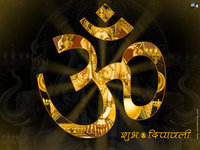
A Hindu , as per modern definition, is an adherent of the philosophies and scriptures of Hinduism, the religious, philosophical and cultural system that originated in the Indian subcontinent.
There are approximately 1 billion Hindus, making Hinduism the third largest religion in the world, of whom approximately 890 million live in India. Other countries with large Hindu populations include Nepal, South Africa, Sri Lanka, Mauritius, Fiji, Guyana, and Indonesia. Hinduism is believed to be the oldest living religious tradition in the world. Ancient or Epic India was known as Hindustan, meaning the „land of Hindus“. Hindustan continues to remain as a popular alternative name for the Republic of India.
Origins of the word Hindu
The origin of the word Hindu is still disagreed upon by historians and linguists. It is generally accepted as having originally been a Persian word for someone who lives around or beyond the Indus River, which is called Sindhu in Sanskrit, and meant any inhabitant of the Indian subcontinent, before the Partition of India. The Indus now flows the length of Pakistan and is locally referred to as „Deriya’e Sindh“. One of Pakistan’s provinces is also named Sindh.
In Persian and Arabic, the term „Hind“ denotes the Indian subcontinent, and the term Hindu (Indu or Intu in China) is still used in some languages to denote a person from the region. A variant of the word was taken into old Greek, and lost the initial aspiration (‚h‘) in modern Greek. This led to the Greek name of ‚India‘.
Alternative explanation is that the word ‚indu‘ originates from Rigveda with reference to a mythological plant juice offered for oblations, while the ‚h‘ represents auspiciousness or delight, thus implying that one who propitiates by drinking soma is a hindu.
Until about 19th century, the term Hindu implied a culture and ethnicity and not religion alone. So Hindus have adopted this term because „Hind“ (India) is their fatherland. The term some Hindus have used for their religious beliefs is Sanatan Dharma („Eternal Code“ – see also Dharma). When the British colonial government started taking a periodic census and established a unified legal system, the need arose to define what constitutes Hinduism as a religion, in order to compare it with the likes of Christianity or Islam.
Since then, various definitions have been proposed by scholars like Bal Gangadhar Tilak, who tried to define it as a religion based on the Vedas, just as the Bible and the Qur’an are the basis of Christianity and Islam, respectively. Although, even an atheist can be a Hindu.
NADA YOGA AND PHILOSOPHY

NADA YOGA AND PHILOSOPHY
Indian music has its essence in a deep sense of spirituality along with roots in Yoga and Indian philosophy. The theme of the compositions is mostly devotional in nature, and many of them also convey abstruse philosophical concepts in a form that is easy to grasp. Music itself, when practised with commitment, is also a form of Yoga. Music has a tremendous effect on the mental state of human beings as it results in peace, concentration, relaxation, spiritual elevation etc, which are the principles of Yoga and meditation. The practice of Yoga techniques, such as breath control and mental concentration, are also closely allied to the study of instrument vocal music.
According to Hindu philosophy, the word for pure sound is Nada Brahma. Nada has also been described by some as the energy of Brahma and it is believed that the propitiation of Nada leads to the attainment of Moksha (salvation), which is the ultimate goal of human life. Matanga has described Nada in his Brihaddesi thus:
„There is no song or music without Nada, there are no musical notes without Nada, there is no dance without Nada and the world is filled with the essence of Nada“.
The word Nada refers to the physical, the mystic and the religious or the cosmic sound. The sound that is produced by musical instruments is an object of sensory perception, as it is grasped by the sense of hearing. This is called Ahata Nada. In this context, the human voice is also a musical instrument. As described by Dr Acharya Trigunateet Jaimini in the composition, Sobhillu Saptaswara, the entire body, including the abdomen (Nabhi), heart (Hrt), neck (Kantha), mouth (Rasana) and nasal passages (Nasa), aids in the production of the sound.
Distinction between Dharma and Religion
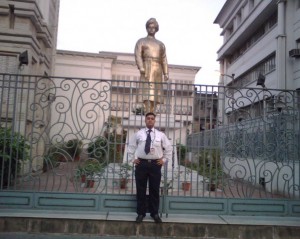
( Sanchin Gupta )
Swami Vivekananda (Bengali: স্বামী বিবেকানন্দ, Shami BibekÄ�nondo; Hindi: स्वामी विवेकानन्द, SvÄ�mi VivekÄ�nanda) (January 12, 1863–July 4, 1902), born Narendranath Dutta is the chief disciple of the 19th century mystic Ramakrishna and the founder of Ramakrishna Mission. He is considered a key figure in the introduction of Vedanta and Yoga in Europe and America and is also credited with raising interfaith awareness, bringing Hinduism to the status of a world religion during the end of the 19th Century. Vivekananda is considered to be a major force in the revival of Hinduism in modern India. He is best known for his inspiring speech beginning with „sisters and brothers of America“, through which he introduced Hinduism at the Parliament of the World’s Religions at Chicago in 1893.
He conducted several public and private lectures, disseminating Vedanta, Yoga and Hinduism in America, England and few other countries in Europe. He also established Vedanta societies in America and England.
-
Distinction between Dharma and Religion – DAVID FRAWLEY
-
Distinction between Dharma and Religion – Vishal Agarwal (17 June 2009)
1. Religions are Proselytizing, Dharma is Self-Transformation :
Why does Religion breed fanaticism whereas Dharma does not? This is explained very succinctly by David Frawley[1]:
“Perhaps nothing more so than religion that stimulates the passions of humanity toward either higher or lower actions. This is because religion introduces absolutes into human life. Religion sets up a standard of judgment that goes beyond life and death and all the limited values of our transient existence. Such a standard can deepen our sensitivity or can breed fanaticism and bigotry, depending upon whether we use these absolutes to provide a higher standard for our own behavior or to become harsher in our criticism of those who think differently than we do. True religion directs us to the Absolute, which requires that we cleanse our minds of our limited opinions and judgments. False or imperfect religion tries to make absolute these very prejudices, opinions and limitations.
To understand religion, we must look at religion as a whole, not as a belief system but as a way of life, a system of ethical, mental and spiritual culture – what is called in the Eastern world, dharma or the guiding law of our being. Otherwise we will be unable to extract the essence of religion from its mass of conflicting beliefs. This requires that we look at our own lives as a whole, and that we examine religion as a living phenomenon, as part of our greater human potential, our inner dharma, from whatever different land or culture it may arise.
We must learn to look at religion as a way of connecting with Reality through our own consciousness, which is the view of the science of Yoga. This is the view of religion that India has given us, the land wherein human beings have spent the most time in pursuit of the sacred, not to convert others, but to realize the Truth.”
AN INTRODUCTION TO VEDIC HEALING

AN INTRODUCTION TO VEDIC HEALING
by Raja Deekshithar
www.rajadeekshithar.com
The Vedas are not only meant for the performance of rituals, and are not only the property of Hindus. They offer great wisdom and knowledge to all of humanity. These can be employed towards the promotion of health and prosperity, and for longevity and sound and peaceful mind for all.
Here we have to ask ourselves, what IS healing? That is, what is ill health, what is good health, and what is the process from the first to the second. I can say, from my spiritual vision, and my masters‘ teaching, that ill health, whether physical or mental, is essentially the occurrence of a gap, or an imbalance, in one’s being. And healing, the process or act of filling this gap or imbalance with the appropriate energy or substance, bringing wholeness. In accordance of the nature of this gap. It is actually part of the nature of our physical embodiment that an imbalance occurs as soon as we are born on this earth.
Thus healing is something nature can do for us, or we can do ourselves. But from the earliest stages of the evolution of humanity some individuals, through vision, training and commitment, have dedicated their lives to help their fellow human beings along the path to healing, which is literally, wholeness. It is the aim of the healer to identify the nature of the gap, as well as to decide on the appropriate energy or substance to fill it with.
WHAT IS BHAKTI-YOGA ?
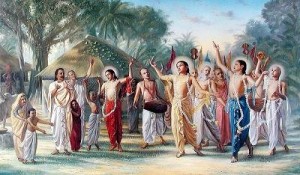
WHAT IS BHAKTI YOGA ?
by Dr. Acharya Trigunateet Jaimini
The term Bhakti comes from the root ‚Bhaj‘, which means ‚to be attached to God‘. Bhajan, worship, Bhakti, Anurag, Prem, Priti are synonymous terms. Bhakti is love for love’s sake. The devotee wants God and God alone. There is no selfish expectation here. There is no fear also. Therefore it is called ‚Parama Prem Rupa‘. The devotee feels, believes, conceives and imagines that his Ishtam (tutelary deity) is an Ocean of Love or Prem. Bhakti is the slender thread of Prem or love that binds the heart of a devotee with the lotus feet of the Lord. Bhakti is intense devotion and supreme attachment to God. Bhakti is supreme love for God. It is the spontaneous out-pouring of Prem towards the Beloved. It is pure, unselfish, divine love or Suddha Prem. There is not a bit of bargaining or expectation of anything here. This higher feeling is indescribable in words. It has to be sincerely experienced by the devotee. Bhakti is a sacred, higher emotion with sublime sentiments that unites the devotees with the Lord. Mark how love develops. First arises faith. Then follows attraction and after that adoration. Adoration leads to suppression of mundane desires. The result is single-mindedness and satisfaction. Then grow attachment and supreme love towards God. In this type of highest Bhakti all attraction and attachment which one has for objects of enjoyment are transferred to the only dearest object, viz., God. This leads the devotee to an eternal union with his Beloved and culminates in oneness.
MIRABAI- Poet, Saint & Bhakti-Tradition
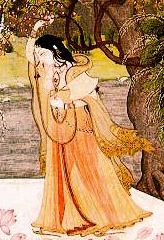
Die Verse der indischen Dichterin und Mystikerin
> Mirabai < (Devanagari मीराबाई, MÄ�rÄ�bÄ�Ä�; * um 1498; † 1546) war eine indische Mystikerin und Dichterin. Sie ist nicht nur wegen ihrer eigenwilligen Persönlichkeit eine höchst faszinierende Frauengestalt der Religionsgeschichte. Ihre ganz persönlich gehaltenen ekstatischen Liebes-, Preis- und Klagelieder sind durch die Jahrhunderte lebendig geblieben und werden noch heute auf dem indischen Subkontinent von Hindus, Sikhs, Muslimen und Christen gleichermaßen rezitiert, gesungen und von den indischen Radiostationen ausgestrahlt. Es gibt zahlreiche Buchausgaben sowie CDs mit Vertonungen der Lieder und Mirabais Leben ist Gegenstand eines Spielfilms. Ihre Verse gehören zum Schatz der Weltliteratur und stehen neben denen der Dichter-Mystiker Hafis, Rumi, > Kabir (satguru, 99 Names of Allah < und > Hildegard von Bingen <.
Perhaps the most remembered and quoted woman in India history is a sixteenth century poet, singer and saint called Mirabai, or Meera. Versions of her songs are sung today all over India, and she appears as a subject in films, books, dances, plays and paintings. Even Mohandas Gandhi promoted her, seeing Mira as a symbol of a woman who has the right to chose her own path, forsake a life of luxury, and in nonviolent resistance find liberation.
Patanjali International Yoga Foundation®
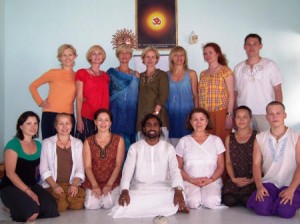
> Patanjali International Yoga Foundation <
„The Basic Principle of our foundation-Truth to the Original Source. We follow the Ancient Yoga Style taken from Sanskrit books“
Mantra of sage Patanjali:
- yogena chittasya padena vacham malam sarirasya cha vaidyakena | yopakaroti tam pravaram muninam patanjalim pranajaliranato’smi ||
- Let us bow the noblest of sages Patanjali, who gave Yoga for serenity of the mind, Sanskrit grammar for purity of speech and Ayurvedic medicine for the perfection of health.
The system of Patanjali Yoga is loyal to the original source taken from the Ancient Sanskrit books.
Yoga Style includes: physical asana, pranayama, bandha, mudra, kriya, chakra and various meditation techniques, as described in the ancient scriptures of the sage Patanjali…
The training program includes Yoga Teachers Training Course (YTTC) 200/500hrs, Yoga-Ayurveda Therapy Course (YATC) 200hrs, intensive one month course, seminars, workshops and retreats. Participation and meeting the course requirements entitles the student with certificate recognized and registered with state government of India.
{„YTTC and YATC“ both courses are suitable for all level of serious yoga students. These courses are not only for teacher or who wants to be a yoga teacher but also suitable for those students who wants to experience of yoga practice, yoga retreats, yoga benefits, health through yoga, correct learning and deep information about yoga.}

